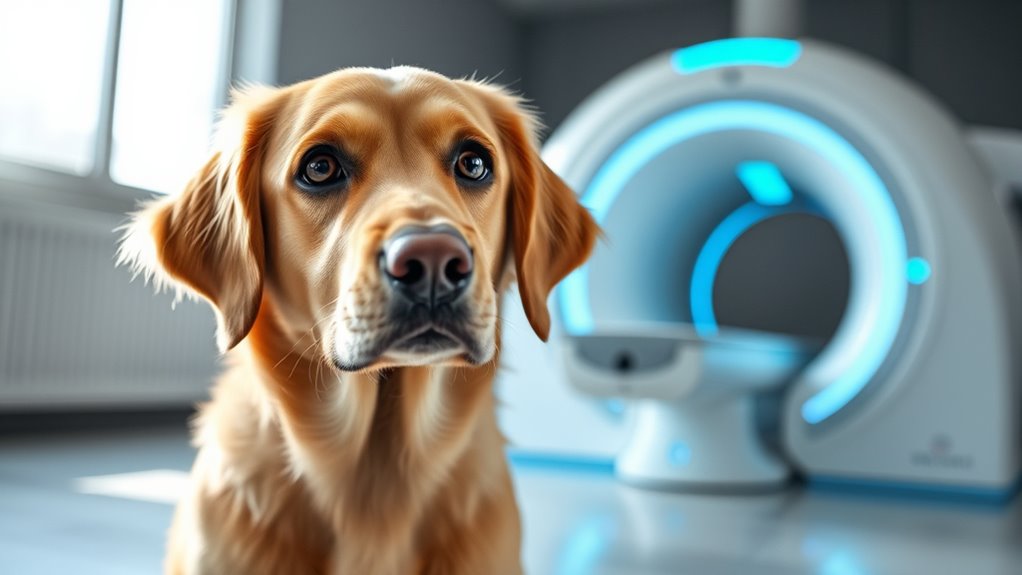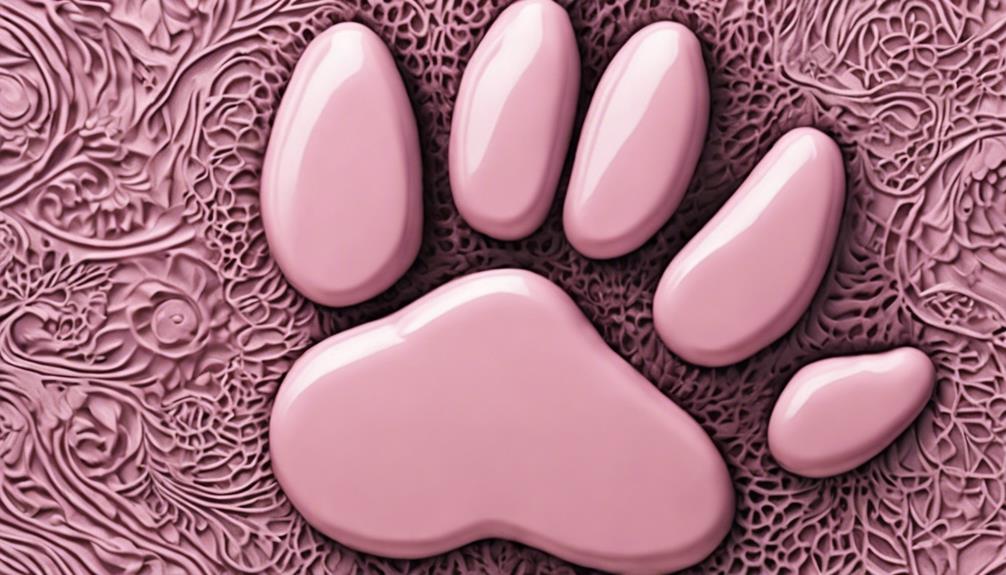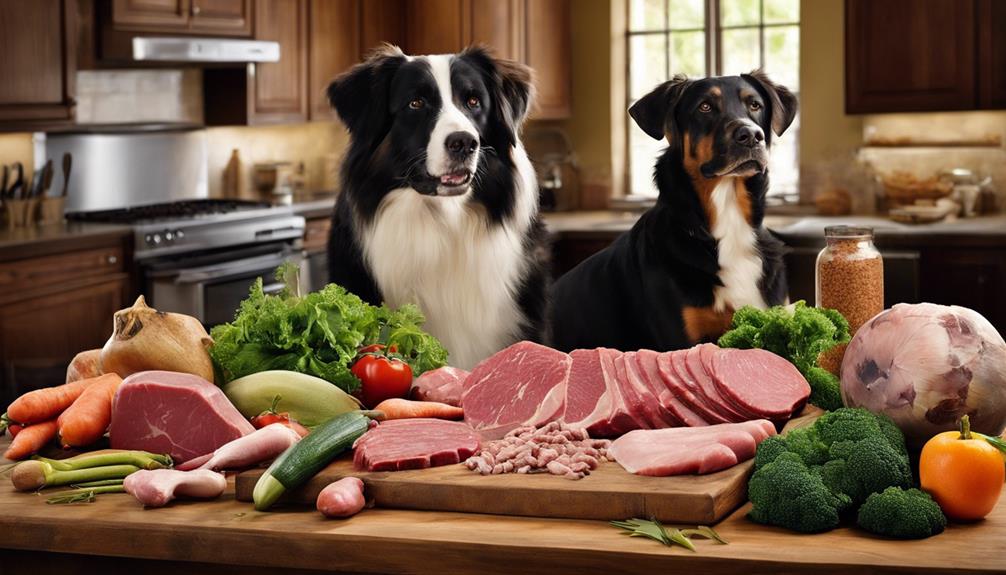Recent brain scan studies show that dogs don’t just smell—they actually “see” scents by visualizing them inside their brains. When dogs sniff, their brains create mental images of odors, making scent perception similar to visual processing. This means they actively interpret and differentiate smells in a detailed, almost picture-like way. If you want to discover how this remarkable ability works and how it impacts their skills, there’s more fascinating information to explore.
Key Takeaways
- Brain scans reveal dogs process scents visually, creating mental images akin to visual perception.
- Olfactory imaging maps scent data into perceptual forms, enhancing scent recognition and differentiation.
- Dogs actively visualize scent environments, integrating visual processing with olfaction for better tracking.
- This discovery improves understanding of canine cognition, aiding in training for detection and search tasks.
- The findings highlight dogs’ complex sensory perception, deepening human appreciation of their natural abilities.

Scientists have discovered that dogs can actually see smells through a brain scan study, revealing a fascinating new side of how their senses work. This groundbreaking research shows that dogs don’t just smell passively; instead, their brains actively process olfactory information in a way that resembles visual perception. When you think about a dog’s sense of smell, you might picture their nose as a highly sensitive instrument. But now, you understand that their brain creates a kind of mental image, thanks to what scientists call olfactory imaging.
Olfactory imaging refers to the brain’s ability to map and interpret scent data into a perceptual form that dogs can recognize and differentiate. In the study, researchers used advanced brain scanning techniques, similar to fMRI scans used in humans, to observe how a dog’s brain responds to different smells. They found that specific regions in the canine brain activate in patterns that suggest the dog is “seeing” the scent—a visual-like representation rather than just detecting molecules. This insight advances our understanding of canine cognition because it shows that a dog’s perception of the world isn’t limited to what their nose picks up but involves complex mental processes that give their olfactory experiences a visual dimension.
Additionally, this research highlights how their brain’s visual processing may be more integrated with their sense of smell than previously thought. Imagine you’re working with a detection dog or simply curious about your pet’s behavior. You now realize that when your dog sniffs around an area, they’re not just passively smelling but actively creating a mental image of the scent landscape. This ability likely helps them distinguish between different odors, track scents over long distances, and identify specific individuals or objects. The brain’s use of olfactory imaging enhances their natural skills far beyond what we previously thought, making their nose a kind of biological camera that captures invisible worlds.
Understanding this aspect of canine cognition can also deepen your appreciation for your dog’s intelligence. Their brains are wired to process scents in a richly detailed way, almost as if they’re “seeing” with their nose. This discovery not only highlights the complexity of their sensory perception but also opens new avenues for training, scent detection, and even helping dogs assist in search and rescue missions. By recognizing that dogs do more than smell—they visualize scents—you can better understand and support their impressive abilities, making your bond even stronger.
Frequently Asked Questions
Can Dogs Distinguish Specific Scents Better Than Humans?
You might wonder if dogs can distinguish specific scents better than humans. The answer is yes—thanks to their incredible olfactory acuity, dogs excel at scent discrimination. Their noses contain up to 300 million scent receptors, compared to about 5 million in humans. This allows them to detect and differentiate even faint odors with remarkable precision, making their scent discrimination far superior to ours.
How Does a Dog’s Brain Interpret Smells Compared to Visual Information?
You might wonder how your dog’s brain processes smells versus visual cues. Thanks to olfactory imaging, scientists see that dogs rely heavily on neural scent processing, which is far more advanced than their visual interpretation. Their brains dedicate a large portion to smell, allowing them to detect and differentiate odors with incredible precision. Unlike humans, who process visual information primarily, your dog’s neural scent processing is central to how they understand and navigate their environment.
Do All Dog Breeds Have the Same Scent Perception Abilities?
Think of a dog’s nose as a finely tuned orchestra, where each breed plays a different tune. Breed differences influence scent sensitivity, meaning some dogs have a keener nose than others. While all dogs excel at scent detection, certain breeds, like Bloodhounds, possess extraordinary olfactory abilities. Your dog’s breed shapes their scent perception, making some noses more like supercharged scanners, while others are more like delicate perfume testers.
Can Training Enhance a Dog’S Ability to Interpret Scent Signals?
You wonder if training can boost your dog’s scent interpretation skills. The answer is yes—scent training and olfactory enhancement activities can markedly improve their ability to detect and interpret smells. By regularly engaging your dog in scent work, you help sharpen their natural olfactory senses, making them more adept at identifying specific scents. Consistent scent training not only enhances their skills but also builds confidence and strengthens your bond.
How Might This “Seeing” of Smells Influence Canine Communication?
You might notice how a dog’s “seeing” of smells influences their communication through scent language. This ability allows them to interpret olfactory vocabulary, enhancing their understanding of other dogs’ signals. When you observe your dog sniffing or marking, they’re actively exchanging scent messages. This superpower deepens their social interactions, making scent-based communication a essential part of their canine vocabulary and helping you better understand their nuanced ways of talking.
Conclusion
So, next time your dog sniffs something intently, remember it’s more than just smelling—they’re actually “seeing” with their brains. It’s like a secret world that mirrors our visual experience, just through scent. Maybe that’s why they often seem to understand things we can’t see. It’s funny how a simple walk can turn into a brain’s eye-opening adventure, revealing just how incredible our furry friends truly are.










